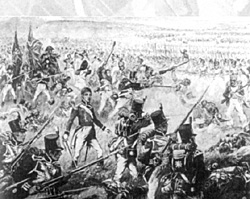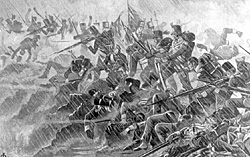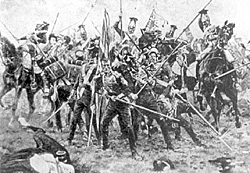The inspiration behind debunking wargames myths was a letter received from Ian Castle regarding the famous anecdote where the Saxon light cavalry at Wagram were supposed to have defeated a regiment of Austrian cuirassiers. Ian firmly debunks this myth. (His letter appears at the end of this article.)
Napoleonic wargaming myths usually include the following: appalling Austrians, pathetic 1806 Prussians and stupid Spanish. The general perception of these armies is that they fought poorly and were repeatedly beaten by the French. So according to wargames logic they must all be poor troops led by worse leaders.
Well I feel that is a little harsh, these armies were professional armies made up of perfectly adequate troops whose only fault was to be led by either outdated or poor leaders, or both. Other such myths surround the rugged Russians, glorious French Guard and brilliant British. Let me deal in detail with the supposed superiority of British infantry in the Napoleonic Wars.
DEBUNKING THE HEROIC BRITISH INFANTRY MYTH
The British army, especially the infantry arm was a very capable and professional force but it was not invincible and its feats of arms where by no means unique for the period. The fact that British infantry (usually in line formation) enjoyed a string of successes against the French armies in Spain does not necessarily mean that they must be inherently superior to all other armies. However in most wargames rules the British army is certainly a cut above the rest. This, one suspects, stems from standard historical works that usually attribute the British army with the following characteristics:
- A) Superior firepower and
B) Superior morale.
Thereby separating it from the run of the mill Napoleonic armies.
THE SUPERIOR FIREPOWER MYTH
The vast number of Peninsular engagements were not won by firepower alone, the British won because of superior tactics. The British tactical method was to fire one or perhaps two volleys and then charge, this tactic proved remarkably successful, with few engagements developing into sustained musketry duels. It was not the superiority of British firepower that won the combat, it was due to battered French columns exposed to skirmish and artillery fire, meeting fresh British infantry. Then attempting to deploy into line whilst under fire before being charged by the British line.
Prolonged musketry duels, the only place where British infantry would have been able to get off their famous "five rounds a minute", were not part of the British tactic and were actively discouraged by the officers at the time. Where such duels did develop there is little evidence of overwhelming British superiority, e.g. at Albuera with the British deployed in line, they engaged French columns for several hours without any success.
British officers discouraged the practice of sustained musketry, not only because it resulted in a lose of discipline and command but due to the fact the results of such action were far from clear. One sergeant in the British Guards at Talavera described indulgence in musketry duels as "a dreadful mistake".
This leads on to an inevitable discussion on the superiority of the British two rank system over the French three ranks. Well, as I have indicated in the above paragraph the fact that whether the infantry were drawn up in two or three ranks did not influence the British practice of volley and then immediately charge. It was the charge that actually defeated the French and not the volley. Yes, one must acknowledge that the initial volley would be enhanced by all muskets coming to bear and may have had slightly greater impact upon the target, but I feel the difference was not that great. Again to use the example of Albuera the British deployment in two ranks did not seem to gain any obvious and immediate battle winning advantage over the French.
 Charles Stadden's painting of the 3rd Foot
Guards at Talavera on July 28th 1809. The Guards got
carried away with themselves on occasion and suffered
heavily in pursuing beaten French columns. The bare headed
officer centre, Robert Dalrymple, killed during the battle.
Sergeants with pikes guard the colours in the
background.
Charles Stadden's painting of the 3rd Foot
Guards at Talavera on July 28th 1809. The Guards got
carried away with themselves on occasion and suffered
heavily in pursuing beaten French columns. The bare headed
officer centre, Robert Dalrymple, killed during the battle.
Sergeants with pikes guard the colours in the
background.
One further factor sometimes attributed to British firepower success is the Brown Bess musket. Occasionally authors and historians have eulogised over the superiority of the Brown Bess when compared to the French Charleville musket, mainly based on the fact that it threw a heavier ball. Frankly, I am at a loss as to how firing a musket ball that is fractionally heavier than ones opponent creates a military advantage. Even the soldiers of the Peninsular regarded the Brown Bess as "of bad quality".
THE SUPERIOR MORALE MYTH
What of the famous British steadfastness in the face of the enemy so often quoted in the history books? This is also a bit of a myth. Well-trained infantry, regardless of nationality, will perform well in the right conditions. The British infantry arm was small, thus it was capable of being trained to a high level and given the excellent state of British coffers the government was actually able to finance decent training.
Therefore British infantry were trained to a level that most larger (and poorer) European armies could not reach. It was this training combined with Wellington's practise of placing his infantry in rear slope or protected positions that allowed them to function to their best effect and hold the advantage at the decisive moment. They did not have to undergo hours of artillery bombardment or skirmish fire before meeting the critical infantry attack. Their combat efficiency had been little eroded. It was this tactical advantage, combined with good training (which engenders good discipline) that gave the British infantry a reputation for staying put under pressure and not some "John Bull" national stereotype.
 The 57th Regiment withstand heavy fire during the battle of Albuera, 1811.
Artist: Lieut Col Marshman
The 57th Regiment withstand heavy fire during the battle of Albuera, 1811.
Artist: Lieut Col Marshman
British infantry showed their fallibility, like all other armies, when placed in precarious positions. E.g. Talavera, where the British Guards overreach themselves and are defeated. Albuera, Colborn's brigade ridden down by lancers. Salamanca, Cole's 4th Division (including the Fusilier brigade), soundly repulsed by Clausel. Quarter Bras provides two further examples, Halkett's brigade broken by French cavalry, even though the 33rd Foot had already formed square. While the Guards brigade at the end of the same battle were attacked by French lancers as they moved out of the Bois de Bossu and suffered severely, (the 1st & 2nd battalions 1st Foot Guards lost over 500 casualties).
So given the circumstances that most European armies fought under the British faired little better.
The myth of British steadfastness has been greatly helped by historians, who although acknowledging defeats often shroud these setbacks in less than forthright language. Examine the wording in many English historical accounts; French defeats are described in very emotive terms, words such as routed or shattered are often used. Similar incidents where British units have been defeated are not described in the same manner, these reverses are usually described in terms such as "handled roughly", or "retired to safety"! E.g. an anonymous sergeant in the Foot Guards wrote.. "Marshal Ney ... brought up his infantry .... and opened a most galling fire from the shelter of the olive trees, this threw our brigade into disorder and we retired rather in an irregular manner."
Another example is the 33rd Foot's defeat at Quatre Bras. This regiment was canistered by French horse artillery whilst in square, broke up and then fled into the Bois du Bossu. This obvious retreat or rout has been simply described as "The 33rd Foot fell back rapidly". It seems that British infantry are not routed, nor do they retreat, they simply retire in an irregular manner. Perhaps British historians are loath to attribute words such as defeat, retreat or rout to Wellington's redcoats. Such language doesn't fit the heroic British infantry stereotype, so it's conveniently substituted for less damaging words. When the fortunes of war are reversed French units are not treated quite so favourably!
A further element to the superiority myth is the "few against many" factor. Accounts of British success against the French were and still are often accompanied, whether knowingly or not, by an inflation of enemy numbers. A picture is painted of vast French columns being brought to a standstill by small, steady British battalions.
This was not generally the case. E.g. At Vimerio, two officers from the 50th Foot (Landmann and Walker) claimed that about 3,000 French attacked their regiment. In fact the number was nearer 1,200. At Waterloo how many times it has been written that the whole of D'Erlon's corps was sent against Picton's thin red line when, in fact, less than half this number actually engaged Picton's units on the ridge.
Also at Waterloo Maitland's Guards are credited with defeating the "French Imperial Guard column". In reality Maitland's two battalions actually outnumbered the two French battalions opposing them. (Maitland had approximately 1,500 in two battalions, while the two French battalions numbered just under 500 each.)
CONCLUSION
The reason for the British infantry success was not a mythical "five rounds a minute" or stoic steadfastness under fire but for the following two main reasons:
First, the small size of the British army. This meant that infantry were thoroughly trained, allowing most regiments to maintain discipline and bring their training to bear at the decisive moment.
Secondly, the basic tactical doctrine employed in the Peninsula under the guiding hand of an exceptional commanding officer. British artillery and skirmishers "softened-up" the attacking French columns, while the infantry's deployment in dead ground kept casualties and general battle fatigue to a minimum. This allowed discipline and order to be maintained through to the decisive moment. The decisive moment being the first contact between the two enemy close order infantry elements. The French having been "softened up" had lost an important element of discipline and order and the British volley and charge was to take full advantage of that.
 British infantrymen attempt to defend the
Colours of their regiment at Albuera, after Colborne's
brigade was ridden down by the lancers of the Vistula
Legion. Artist: WB Wollen
British infantrymen attempt to defend the
Colours of their regiment at Albuera, after Colborne's
brigade was ridden down by the lancers of the Vistula
Legion. Artist: WB Wollen
So the next time you're playing a wargame with a British army, perhaps you should examine the rules and see if they allocate extra bonuses to the British army that appertain more to wargaming myth than historical fact. Yes, the British infantry should get bonuses for exceptionally well-trained troops, but were they really any better trained than the French army of 1805, or the Prussian army of 1806? Do they really deserve those increased morale and firepower ratings?
Debunking Myths Part 2: Ian Castle Letter
Back to Table of Contents -- Age of Napoleon #31
Back to Age of Napoleon List of Issues
Back to MagWeb Master Magazine List
© Copyright 1999 by Partizan Press.
This article appears in MagWeb (Magazine Web) on the Internet World Wide Web. Other military history articles and gaming articles are available at http://www.magweb.com